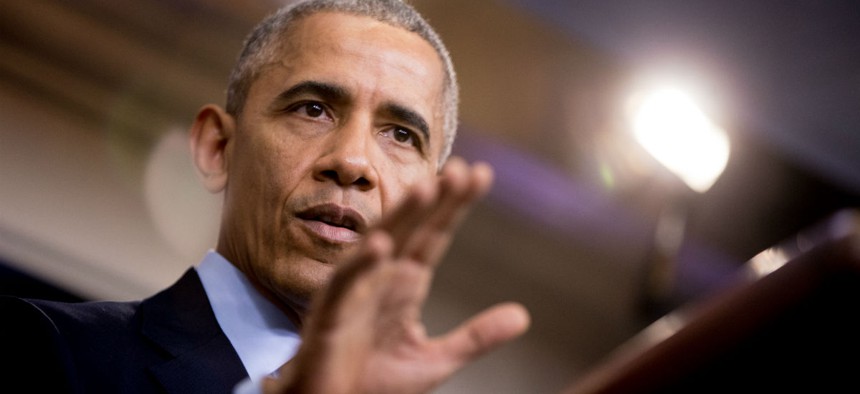
President Obama speaks during a White House news conference Dec. 16. AP Photo/Andrew Harnik
Obama Just Made it Harder for Trump to Create a Muslim Registry
The government is dismantling a dormant program that was used to track people from Muslim-majority countries.
The Department of Homeland Security will take apart the vestiges of a controversial program that was used to register and track visitors from Muslim-majority countries, a move which will make it more difficult for Donald Trump to instate a registry system for Muslims once he takes office next month.
The change, which comes just four weeks before the end of President Obama’s last term, removes the skeleton of a program that hasn’t been in use since 2011. When it was active, the “special registration” program—the National Security Entry-Exit Registration System, or NSEERS—had two parts, and applied only to people from 25 countries named by DHS. Twenty-four of them were Muslim-majority countries.
One half of NSEERS was a domestic “call-in” registration program that required men ages 16 and up living in the U.S. to report regularly to immigration officials. The other half was an entry and exit tracking system, which limited the airports, seaports, and land borders that registrants could use to travel, and required them to register before leaving and after arriving.
NSEERS began in September 2002. The domestic call-in program was ended in December 2003, and the remaining entry and exit program was suspended in 2011, when DHS removed all 25 countries from the list of required participants. At the time, civil-rights groups asked the Obama administration to remove the regulations entirely, to prevent the program from being resurrected, and had intensified their calls recently, after Trump suggested using “watchlists” or “registries” to surveil Muslims in the U.S.
The complete dismantling of NSEERS doesn’t prevent Trump from creating a new program to track people from Muslim-majority countries. But nor is it only a symbolic rejection of similar programs from the outgoing president. Leaving the program in place would have given Trump a turnkey registry in waiting.
“DHS ceased use of NSEERS more than five years ago, after it was determined the program was redundant, inefficient and provided no increase in security,” a spokesperson for the agency said Thursday. “The intervening years have shown that NSEERS is not only obsolete, but that its use would divert limited personnel and resources from more effective measures.”
A 2012 report from the DHS inspector general found that the program used buggy technology, relied on faulty databases, and cost the government $10 million per year to run. The inspector general recommended dismantling the program entirely, but the agency declined to follow that recommendation at the time.
On Friday, when the government’s official notice will be printed in the Federal Register, the regulations behind the special-registration program will no longer exist.







